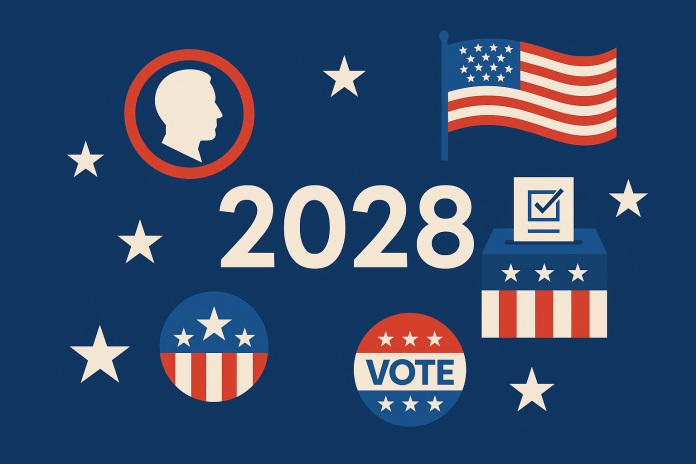The United States presidential election is one of the most complex and widely watched political events in the world. As the country prepares for the 2028 Presidential Election, millions of Americans—and foreign observers—want to understand how the process actually works.
From primaries to conventions, and from debates to the Electoral College, this guide breaks down the entire U.S. election structure in simple, beginner-friendly language.
How the 2028 U.S. Presidential Election Works
The election process has four major stages:
-
Primary Elections & Caucuses
-
National Party Conventions
-
General Election Campaign
-
Electoral College Vote
Each stage plays a critical role in selecting the next President.
⭐ 2. Primary Elections & Caucuses (Early–Mid 2028)
Before candidates run for President in the general election, they must win support from their political party.
This happens through:
✔ Primaries
People vote privately, using ballots at polling stations—similar to normal elections.
✔ Caucuses
Voters meet in groups, discuss the candidates, and select delegates through a public vote.
Primary Purpose:
To select delegates who represent each state at the party’s national convention.
Who Votes?
-
Registered party members
-
Independent voters (in “open primary” states)
Key Early Primary States:
-
Iowa (caucus)
-
New Hampshire (primary)
-
South Carolina
-
Nevada
These early states help shape national momentum.
⭐ 3. National Party Conventions (Summer 2028)
Each major party — Democratic and Republican — holds a national convention to:
✔ Officially nominate their presidential candidate
✔ Announce the vice-presidential running mate
✔ Approve the party’s policy platform
Delegates selected during primaries cast their votes for the candidate they represent.
If a candidate has enough delegates, they win the nomination easily.
If not, a contested convention may occur where delegates vote multiple times.
⭐ 4. General Election Campaign (Mid–Late 2028)
Once both parties nominate their candidates, the general election begins.
This stage includes:
✔ Nationwide campaign events
✔ Presidential debates
✔ Advertising, rallies, interviews
✔ Fundraising and endorsements
Key Issues for 2028 May Include:
-
Economy & inflation
-
Healthcare
-
Immigration
-
Foreign policy
-
Energy & climate
-
Technology & jobs
-
National security
Voters choose between the party nominees, independent candidates, or third-party candidates.
⭐ 5. Election Day: Tuesday, November 7, 2028
U.S. Presidential Election Day always falls on:
➡ the first Tuesday after the first Monday in November
In 2028, that date is November 7.
Millions of Americans vote nationwide either by:
-
In-person voting
-
Early voting
-
Mail-in ballots
-
Absentee ballots
But these votes do not directly elect the President.
They determine how each state’s Electoral College votes.
⭐ 6. How the Electoral College Works (The Deciding Stage)
The U.S. does not use a direct popular vote system.
Instead, it uses the Electoral College with 538 total electors.
✔ A candidate needs 270 electoral votes to win.
Each state gets a number of electors based on its population:
-
Big states like California, Texas, Florida, New York have more electors.
-
Smaller states like Wyoming, Alaska, Vermont have fewer.
Winner-Take-All Rule
Most states give all electoral votes to whichever candidate wins the state’s popular vote.
Maine & Nebraska differ
They use a split system, dividing electoral votes by district.
⭐ 7. Swing States Will Decide the Election
Some states consistently vote Democrat or Republican.
But swing states can go either way.
Examples include:
-
Pennsylvania
-
Michigan
-
Wisconsin
-
Arizona
-
Georgia
-
Nevada
-
North Carolina
These states receive the most campaign attention because they often decide the final outcome.
⭐ 8. When Is the Winner Official?
The election is confirmed in two steps:
✔ Electors cast their votes (December 2028)
Electors meet in their states and vote for President and Vice President.
✔ Congress certifies the results (January 2029)
A joint session of Congress officially counts the votes.
Once certified, the winning candidate becomes the President-elect.
⭐ 9. Inauguration Day: January 20, 2029
The newly elected President takes the Oath of Office and is sworn in on:
➡ January 20, 2029
This marks the official start of the new presidential term.
⭐ Conclusion
The U.S. Presidential Election is a long and detailed process involving primaries, conventions, a nationwide campaign, and the Electoral College. Understanding each step helps voters and global observers follow the 2028 election with clarity.
The system may seem complicated, but it ensures states play a balanced role in selecting the nation’s leader.



